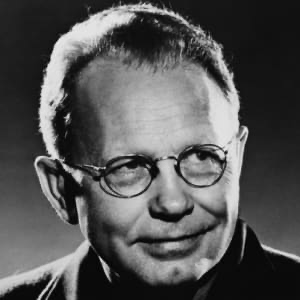Grant Wood
American, (1891–1942)
Grant Wood grew up on a farm outside the tiny town of Anamosa, Iowa, relocating to Cedar Rapids with his mother and three siblings when his father died in 1901. After high school he spent summers at the Minneapolis School of Design, Handicraft, and Normal Art. His artistic training was inconsistent; despite study at the University of iowa and the Art Instittue of Chicago, he never earned a degree. He served stateside in the army at the end of WWI, then taught school in Cedar Rapids whie living with his mother, an arrangement he maintained, save during his four trips to Europe, until her death in 1935. He enjoyed decorating projects for several Iowa hotels, businesses, and residences and founded a community theater in Cedar Raids, where in 1928 he executed the huge, twenty-four-foot stained-glass Veterans Memorial Window, supervising its manufacture in Munich. Around this time, he switched from paiinting what he called "Europy" scenes impressionistically to indigenous subjects in a crisp, hard-edge style.
Instantly famous thanks to "American Gothic" (1930), Wood became associated with Regionalism in the early 1930s, founding the summer Stone City Art Colony in northeast iowa to encourage art-making and art appreciation in the heartland. He invited the local farmers and townspeople to the colony for weekly exhibitions and sales, hoping to broaden their attitudes toward ar.t The experiment ended after two years, leaving him deeply in debt. With a comissions for a mural cycle at Iowa State University in Ames, Wood became state director of the Public Works of Art Project (PWAP) in 1933. Resented by a number of his assistants, who petitioned for his removal, he resigned in 1935. Through his employment with the PWAP, he was offered a teaching positiion at the University of Iowa in Iowa City. This began a series of emotionally exhausting battles--his brief marriage and bitter divorce; financial woes; attacks on his art, teaching, and character by fellow faculty members; and mean-spirited rumors of his homosexuality. Although he was represented by a New York gallery and marketed prints through Associated American Artsists, he struggled in the late 1930s to regain solvency. He died of cancer in iowa City hospital in 1942.
Excerpt from: Taylor, Sue, "Regional Unreal," Art in America, June/July 2018, pp 98-105.
American, (1891–1942)
Grant Wood grew up on a farm outside the tiny town of Anamosa, Iowa, relocating to Cedar Rapids with his mother and three siblings when his father died in 1901. After high school he spent summers at the Minneapolis School of Design, Handicraft, and Normal Art. His artistic training was inconsistent; despite study at the University of iowa and the Art Instittue of Chicago, he never earned a degree. He served stateside in the army at the end of WWI, then taught school in Cedar Rapids whie living with his mother, an arrangement he maintained, save during his four trips to Europe, until her death in 1935. He enjoyed decorating projects for several Iowa hotels, businesses, and residences and founded a community theater in Cedar Raids, where in 1928 he executed the huge, twenty-four-foot stained-glass Veterans Memorial Window, supervising its manufacture in Munich. Around this time, he switched from paiinting what he called "Europy" scenes impressionistically to indigenous subjects in a crisp, hard-edge style.
Instantly famous thanks to "American Gothic" (1930), Wood became associated with Regionalism in the early 1930s, founding the summer Stone City Art Colony in northeast iowa to encourage art-making and art appreciation in the heartland. He invited the local farmers and townspeople to the colony for weekly exhibitions and sales, hoping to broaden their attitudes toward ar.t The experiment ended after two years, leaving him deeply in debt. With a comissions for a mural cycle at Iowa State University in Ames, Wood became state director of the Public Works of Art Project (PWAP) in 1933. Resented by a number of his assistants, who petitioned for his removal, he resigned in 1935. Through his employment with the PWAP, he was offered a teaching positiion at the University of Iowa in Iowa City. This began a series of emotionally exhausting battles--his brief marriage and bitter divorce; financial woes; attacks on his art, teaching, and character by fellow faculty members; and mean-spirited rumors of his homosexuality. Although he was represented by a New York gallery and marketed prints through Associated American Artsists, he struggled in the late 1930s to regain solvency. He died of cancer in iowa City hospital in 1942.
Excerpt from: Taylor, Sue, "Regional Unreal," Art in America, June/July 2018, pp 98-105.
Artist Objects
In the Spring 1986.002
Sultry Night 1986.040



